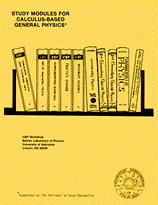Instructional Materials in Physics and Astronomy
Date of this Version
1975
Abstract
As you read this sentence you will experimentally demonstrate the general gas law at least once by breathing in and out. As you expand the volume in your lungs, the pressure drops and air comes in; as you decrease the lung volume the pressure rises and air goes out. Pressure (p) and volume (V) are related; at constant temperature, pV = const.
This relation, called Boyle's law, was well established before the atomic theory of matter was accepted. In this module you will learn how to apply much of your knowledge of Newton's laws, kinetic energy, momentum, and elastic collisions to molecular motion. The fact that you can derive the macroscopic general gas law from Newtonian mechanics applied to molecules should give you further insight into the remarkable simplification Newton wrought in our understanding of matter. You will show that his laws hold equally well for masses 1027 times smaller and dimensions 1010 times smaller than the blocks and inclined planes we have discussed in previous modules. Newton's laws work from planetary physics to microphysics, an astronomical range!
To be sure, we have overstated the case in order to make a point. The behavior of an ideal gas is just that, idealized, and real gases only approximately behave this way. At the molecular level the fundamental "graininess" or quantization of momentum and energy as well as matter becomes important so that kinetic theory is also an idealization of nature.



Comments
From Study Modules for Calculus-Based General Physics
Copyright © 1975 CBP Workshop, University of Nebraska–Lincoln.
Reproduction rights granted.